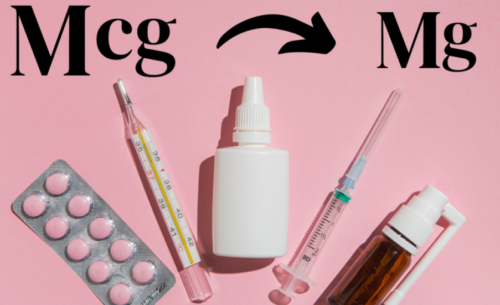Understanding Basics before streamlining Mcg to Mg conversion: Defining Mcg & Mg
Table of Contents
Let’s define micrograms (mcg) and milligrams (mg):
Micrograms (mcg)
Micrograms are a unit of mass or weight in the metric system.
The symbol for micrograms is “mcg” or sometimes “µg”, where the Greek letter mu (µ) stands for “micro”.
A microgram is equal to one millionth of a gram (1 mcg = 0.000001 gram).
Micrograms are often used to measure very small amounts to express the dosage of drugs or the content of certain nutrients in food, especially in the fields of medicine and nutrition.
Milligrams (mg)
Milligrams is a unit of mass in the metric system.
The symbol for milligrams is “mg.”
A milligram is equal to one thousandth of a gram (1 mg = 0.001 gram).
Milligrams are usually used to measure quantities larger than micrograms but smaller than grams. They are often used in medicines, dietary supplements and in various scientific and medical contexts.
In summary, micrograms and milligrams are both units of mass in the metric system, with micrograms being a smaller unit than milligrams. The conversion factor between them is that 1 milligram is equal to 1,000 micrograms.
A common problem people encounter while streaming Mcg to Mg conversion.
A common problem people encounter while streamlining Mcg to Mg conversion is the scale difference between the two units. The prefix “micro” refers to a factor of 10^-6, while “milli” represents a factor of 10^-3. Therefore, there are 1,000 micrograms in one milligram.
Confusion arises when individuals need to convert doses between mcg and mg, especially in the case of drugs, dietary supplements, or other substances where accurate dosage is critical.
For example:
– 1 mg = 1,000 mcg
– 0.5 mg = 500 mcg
– 2.5 mg = 2,500 mcg
To switch from micrograms to milligrams, just divide the number of micrograms by 1,000.Conversely, to convert from milligrams to micrograms, you multiply the number of milligrams by 1,000.
A common mistake is to not recognize the need for this conversion factor, leading to incorrect dosages or measurements. Being aware of these transitions is essential to ensure accurate and safe administration of materials.

Calculator
Unit Conversion: mg to mcg and mcg to mg
Practical Example
Some examples to illustrate the concepts of micrograms (mcg) and milligrams (mg):
Example 1: Micrograms (mcg)
Suppose you have a vitamin supplement that provides 500 micrograms of vitamin B12. This mean:
500 mcg of vitamin B12 = 0.5 mg (because 500 mcg / 1000 = 0.5 mg)
Therefore, the supplement contains 0.5 milligrams of vitamin B12.
Example 2: Milligrams (mg)
Now, let’s say you have a prescription medication and the recommended dose is 15 milligrams. It indicates:
15 mg = 15,000 mcg (because 15 mg * 1000 = 15,000 mcg)
Therefore, the prescribed dose is equal to 15,000 micrograms.
Example 3: Food nutrition
Consider the nutrition information on a food label, which indicates that one serving contains 2.5 mg of iron. To convert this to micrograms:
2.5 mg = 2,500 mcg (because 2.5 mg * 1000 = 2,500 mcg)
Therefore, a serving of food contains 2,500 micrograms of iron.
In these examples, you can see the conversion between micrograms and milligrams. Being aware of these conversions is essential to ensure accurate dosages and measurements, especially in medical and nutritional contexts.
FAQ’s on streamlining Mcg to Mg conversion.
Q1: What is the conversion factor between micrograms (mcg) and milligrams (mg)?A: The conversion factor is 1 milligram (mg) equal to 1,000 micrograms (mcg).
Q2: How do I convert micrograms to milligrams?A: To convert micrograms to milligrams, divide the number of micrograms by 1,000. For example, 2,500 mcg is equal to 2.5 mg (2,500 / 1,000).
Q3: Why is it important to know the conversion between mcg and mg?A: Understanding this transition is critical in various fields such as healthcare, nutrition, and pharmaceuticals, where accurate dosage calculations are essential for accurate administration and formulation.
Q4: Can you give a quick mental trick for mcg to mg conversion?A: Think of it as shifting the decimal point three places to the left. For example, 800 mcg is 0.8 mg (800 / 1,000).
Q5: Are there any common mistakes to avoid during the transition?A: Ensure consistency in units and beware of decimal placement. Double check calculations to prevent errors, especially when dealing with large numbers.
Q6: How do professionals streamline mcg to mg conversions in their work?A: Professionals often use technology such as mental math, conversion factors, and calculators for quick and accurate conversions. Mnemonics and shortcuts are also used for easy recall.
Q7: Are there any industry-specific considerations for mcg to mg conversion?A: In healthcare and pharmaceuticals, professionals often think in terms of dosage ranges, reinforcing their familiarity with common transition scenarios.
Q8: How can I teach others about mcg to mg conversion?A: Emphasize the importance of the 1,000:1 conversion factor, provide practical examples, and encourage the use of mental math or mnemonics for better retention.
Q9: Is there a difference in converting mcg to mg within the metric system?A: No, the conversion is constant in the metric system. A 1,000:1 ratio is the universal standard for micrograms to milligrams.
Q10: Are there any online tools or apps for mcg to mg conversion?A: Yes, several online converters and mobile apps help with mcg to mg conversions, providing a quick and convenient solution.
